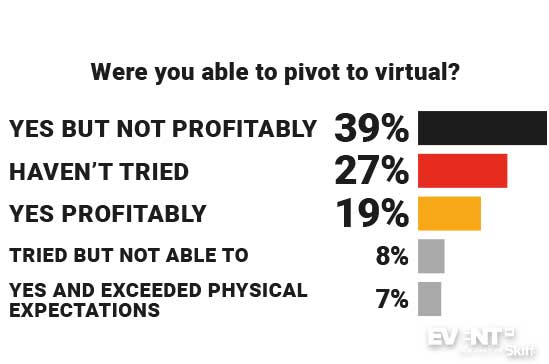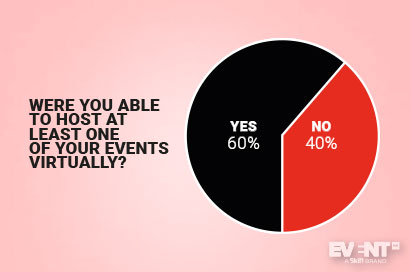In fact, 40 percent of respondents to a recent EventMB survey answered “no” when asked if they had been successful at pivoting their events to a virtual platform. When asked to evaluate their successes in terms of a sliding scale instead of a yes or no answer, roughly 60 percent of respondents had less than ringing endorsements: 27 percent did not even try pivoting to virtual, 8 percent had tried but failed, and 38 percent made it work — but not profitably.

Part of the issue may be a steep learning curve, both on the part of event planners and the tech companies that serve them. Many are looking to existing event apps as a model for their virtual platforms, but those features are often designed to supplement rather than replace the in-person experience.
Now, planners are faced with a much taller order: How do you deliver value on par with the live experience through a digital interface? Almost 50 percent of respondents indicated that “[t]he inability to match live engagement” was one of their biggest sources of frustration with virtual event tech.
Why might virtual event tech not be delivering a solution for all planners? Here’s our take.
Why Hasn’t the Pivot to Virtual Been a Success Story for Everyone?
Market Factors
In some ways it comes down to simple market factors. Trade shows, for example, rely heavily on face-to-face interactions. Their success hinges on happenstance encounters for new leads and private meetings for major business deals, experiences that are not easy to replicate through a virtual platform.
The 2020 Global Meetings Events Forecast reported that conferences and tradeshows accounted for 13 percent of business events in North America — this number goes up to 16 percent for Europe and 17 percent for Asia Pacific. This is compounded by the fact that, according to our research, over 10 percent of the providers who participated do not offer any features that specifically cater to trade shows.
With trade shows representing this high of a percentage of the industry and with the emerging tech seemingly concentrating on serving other types, it’s not so surprising that 27 percent of our respondents did not even attempt the transition to a virtual experience.
Uncertain Long-term ROI
Almost a quarter of the respondents to The Virtual Event Tech Guide survey said that “[u]ncertainty about the long-term benefit of investing in it” was the biggest disincentive in sourcing event tech.
The question of upfront costs relative to long-term benefits and ROI will depend partly on an economy of scale. How long is this crisis going to last, and is it really worth investing in a whole new method of delivery when so much is still uncertain?
Organizations that can repurpose a single virtual platform for multiple events will be more inclined to make the investment than small-scale planners who manage a single event per year. For the latter, it might seem less risky to postpone their events in the hopes that in-person gatherings resume.
Reluctance to Adopt New Technologies
This is compounded by the fact that the events industry is one that often seems slow to pick up on tech trends, even when there are few other options. Old routines can be difficult to shake and veteran event planners who have never used virtual event tech before may be reluctant to make the leap to virtual if they don’t have to.
Beyond the financial investment, new tech often involves dedicating time and effort into researching options and learning new skills. Over 20 percent of our survey respondents cited lack of tech knowledge as the biggest challenge in pivoting to virtual. Moreover, almost 60 percent rated themselves as less than comfortable with virtual event tech.
In nutshell, the biggest challenges involve:
- Capturing the practical value of face-to-face encounters
- Anticipating ROI in the long term
- Developing sufficient familiarity with event tech
What Needs to Happen for Virtual Events to Reach Their Potential
Ultimately, all of these issues boil down to a disconnect between the available tech and event planner needs. Event tech vendors need to offer innovative solutions to the engagement needs of planners; otherwise, it just doesn’t seem worth the time or the money. This crisis is making practical solutions all that much more valuable. There are no margins left for bells and whistles. Tech features need to deliver on a pragmatic level.
To make it worth their while, virtual event tech needs to deliver on two promises: maximal engagement and profitable margins.
The second of these largely relies on the success of the first, because planners set their ticket price based on the value they expect to deliver for attendees.
Meeting Demand for More Engaging Event Tech
In the research conducted for The Virtual Event Tech Guide 2020, we found that the most common engagement features are still the old standbys of live polls and Q&As. This technology is a little stale now, and while it can enhance an in-person experience, remote participation demands more advanced engagement features to compensate for the lack of face-to-face interaction.
Delivering More Advanced Networking Features
Part of what makes events irreplaceable is simply the experience of being around other people, and while that may be difficult to translate in a virtual setting, advanced networking features can go a long way in this direction. Again, The Virtual Event Tech Guide found that only about half of tech vendors provided an interface for scheduling 1-on-1 meetings and private video chats.
Further, less than 36 percent provided any kind of matchmaking service, which is one area where AI could really be leveraged to optimize the potential for remote interaction between attendees. This kind of curation would be valuable under any circumstances, but it is especially useful when the interpersonal dynamics of face-to-face encounters are removed. Having meaningful interactions is difficult enough on a show floor with thousands of people, never mind when the majority of people are logging in from remote locations.
Facilitating Business Interactions and Data Collection
An under-utilized benefit of digital platforms is the potential to automate lead generation and data collection, particularly in the context of trade shows. Virtual platforms should provide the opportunity not just for live product demos, but also for gathering leads from any attendees who interact with the virtual booth. According to our research, only a little more than half of the providers we surveyed offered lead generation data from attendee interactions with booths (55 percent) and less than half (48 percent) offer lead generation from live demos.
Additionally, exhibitors should be given information on how long each visitor spends in different sections of the virtual booth. The more exhibitors understand their potential clients, the closer they are to closing a deal.
Refining the Revenue Potential of Virtual Spaces an Audiences
Just over 62 percent of respondents said they will continue to maintain their virtual strategy once live events resume. By the same token, just shy of 62 percent respondents said that the cost of event tech doesn’t reflect the revenue potential of their virtual events — a concerning figure considering that event tech is in many cases the only expense for virtual events. Vendors need to provide features that will help tip these scales for planners and their stakeholders.
In order to help planners justify their virtual event tech investments in the short term, vendors need to improve the sponsorship and monetization options within the platforms themselves, and providing the data required to track engagement with sponsors and substantiate ROI will inevitably become a baseline expectation.
IN CONCLUSION
At the end of the day, B2B event planners are running businesses, and they need to make a profit. While there is some value in meeting basic client needs with passable virtual events, planners need to do more than maintain a relationship with their client base. They need to be able to recoup their losses.
To address this need, event tech needs to:
- Offer innovative forms of digital engagement
- Replicate the networking and lead-generation potential of live events
- Demonstrate enough practical value to justify charging profit-generating ticket prices
In short, vendors need to offer services that have a clear ROI from both the event planners’ and the attendees’/exhibitors’ perspective. It’s not just the icing on the cake anymore. It’s the main course.





